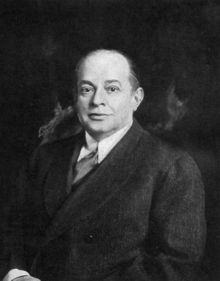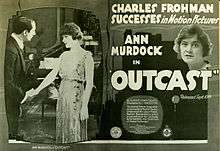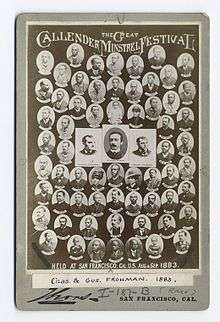Charles Frohman
| Charles Frohman | |
|---|---|
 Frohman in 1914 | |
| Born |
July 15, 1856 Sandusky, Ohio, U.S. |
| Died |
May 7, 1915 (aged 58) RMS Lusitania, Atlantic Ocean |
| Occupation | Producer |
Charles Frohman (July 15, 1856 – May 7, 1915) was an American theatrical producer. Frohman was producing plays by 1889 and acquired his first Broadway theatre by 1892. He discovered and promoted many stars of the American theatre.
In 1896, Frohman co-founded the Theatrical Syndicate, which grew to exert monopoly control over the U.S. theatre industry for nearly two decades. He also leased the Duke of York's Theatre in London, promoting such playwrights as J. M. Barrie, producing Barrie's Peter Pan, or The Boy Who Wouldn't Grow Up, which he debuted at the Duke of York's in December 1904 and opened in the U.S. in January 1905. The American opening starred a Frohman favorite, Maude Adams. He partnered with English producers, including Seymour Hicks, with whom he produced a string of London hits prior to 1910, including Quality Street, The Admirable Crichton, The Catch of the Season, The Beauty of Bath, and A Waltz Dream. Many of his London successes also enjoyed runs in New York.
Frohman produced over 700 shows. At the height of his career, he died in the 1915 sinking of the RMS Lusitania.
Life and career
Charles Frohman was born in Sandusky, Ohio, the youngest of three Frohman brothers, including Daniel and Gustave. The year of his birth date is generally erroneously reported as 1860, and his birthday is shown as July 16 on his tombstone, but the correct date is July 15, 1856.[1] In 1864, Frohman's family moved to New York City. At the age of twelve, Frohman started to work at night in the office of the New York Tribune, attending school by day. In 1874, he began work for the Daily Graphic and at night sold tickets at Hooley's Theatre, Brooklyn. In 1877, he took charge of the Chicago Comedy Co., with John Dillon as star in Our Boys. He next joined Haverly's United Mastodon Minstrels as manager, touring the U.S. and Europe. Then for a time he was associated with his brothers Daniel and Gustave in managing the Madison Square Theatre, New York.[2] He began to produce plays by 1886.[3]


Frohman's first success as a producer was with Bronson Howard's play Shenandoah (1889). Frohman founded the Empire Theatre Stock Company to acquire his first Broadway theatre, the Empire, in 1892. The following year, he produced his first Broadway play, Clyde Fitch's Masked Ball. In this piece, Maude Adams first played opposite John Drew, which led to many future successes. Soon Frohman acquired five other New York City theaters, including the Garrick and Criterion Theatres. Working with William Harris and Isaac B. Rich, he became part owner of their theatres in Boston (the Columbia Theatre, Park, Hollis Street, Colonial, Boston and Tremont).[4] In 1895, he produced the New York premiere of The Importance of Being Earnest, by Oscar Wilde. The same year, he produced The Shop Girl.[3]
Frohman was known for his ability to develop talent. His stars included William Gillette, John Drew, Jr., Ethel Barrymore, Billie Burke, E. H. Sothern, Julia Marlowe, Maude Adams, Paul Gilmore, Evelyn Millard, Henry Miller and Walter E. Perkins. In 1896, Frohman, Al Hayman, Abe Erlanger, Mark Klaw, Samuel F. Nixon, and Fred Zimmerman formed the Theatrical Syndicate. Their organization established systemized booking networks throughout the United States and created a monopoly that controlled every aspect of contracts and bookings until the late 1910s, when the Shubert brothers broke their stranglehold on the industry.
In 1897, Frohman leased the Duke of York's Theatre in London, introducing plays there as well as in the United States. Clyde Fitch, J. M. Barrie and Edmond Rostand were among the playwrights he promoted. As a producer, among Frohman's most famous successes was Barrie's Peter Pan, or The Boy Who Wouldn't Grow Up, which he premiered at the Duke of York's in December 1904 starring Nina Boucicault, and produced in January 1905 in the U.S. starring Maude Adams. In the early years of the 20th century, Frohman also established a successful partnership with English actor-producer Seymour Hicks to produce musicals and other comedies in London, including Quality Street in 1902, The Admirable Crichton in 1903, The Catch of the Season in 1904, The Beauty of Bath in 1906, The Gay Gordons in 1907, and A Waltz Dream in 1908, among others. He also partnered with other London theatre managers. The system of exchange of successful plays between London and New York was effected largely as a result of his efforts. In 1910, Frohman attempted a repertory scheme of producing plays at the Duke of York's. He advertised a bill of plays by J. M. Barrie, John Galsworthy, Harley Granville Barker, and others. The venture began tentatively, and while it may have proved successful, Frohman canceled the scheme when London theatres closed at the death of King Edward VII in May 1910.
Other Frohman hits included The Dollar Princess (1909), The Arcadians (1910), The Sunshine Girl (1913) and The Girl From Utah (1914).[3] By 1915, Frohman had produced more than 700 shows, employed an average of 10,000 people per season, 700 of them actors, and paid salaries totaling $35 million a year (the equivalent of more than $700 million in 2010 dollars).[5] Frohman controlled five theaters in London, six in New York City, and over two hundred throughout the rest of the United States. His longtime live-in companion, theatre critic Charles Dillingham (1868–1934), also became a well-known producer.[3]
Death on the RMS Lusitania

Frohman made his annual trip to Europe in May 1915 to oversee his London and Paris “play markets”, sailing on the Cunard Line’s RMS Lusitania. Songwriter Jerome Kern was meant to accompany him on the voyage, but overslept after being kept up late playing requests at a party.[6] William Gillette was also to have accompanied him, but was forced to fulfill a contracted appearance in Philadelphia.[7]
Frohman's rheumatic knee, from a fall three years earlier, had been ailing for most of the voyage, but he was feeling better on the morning of May 7, a bright, sunny day. He entertained guests in his suite and later at his table. He was regaling them with tales of his life in the theater when, at 2:10 in the afternoon, within fourteen miles of the Old Head of Kinsale, with the coast of Ireland in sight, a torpedo from the German U-boat U-20 struck the Lusitania on the starboard side. Within a minute, there was a second explosion, followed by several smaller ones.[8]
As passengers began to panic, Frohman stood on the promenade deck, chatting with friends and smoking a cigar. He calmly remarked, “This is going to be a close call."[9] Frohman, with a disabled leg and walking with a cane, could not have jumped from the deck into a lifeboat, so he was trapped. Instead, he and millionaire Alfred Vanderbilt tied lifejackets to “Moses baskets” containing infants who had been asleep in the nursery when the torpedo struck. Frohman then went out onto the deck, where he was joined by actress Rita Jolivet, her brother-in-law George Vernon and Captain Alick Scott. In the final moments, they clasped hands and Frohman paraphrased his greatest hit, Peter Pan: “Why fear death? It is the most beautiful adventure that life gives us." Jolivet, the only survivor of Frohman's party, was standing with Frohman as the ship sank. She later said, “with a tremendous roar a great wave swept along the deck. We were all divided in a moment, and I have not seen any of those brave men alive since."[10]
Frohman died a month and a week short of his fifty-ninth birthday. His body was later washed ashore below the Old Head of Kinsale, and it was later determined that he was killed by a heavy object falling on him, rather than by drowning. His body lay among 147 others awaiting identification, where a rescued American identified it from newspaper photographs. His body, alone among all the others, was not disfigured.[11] His funeral service was held on May 25 at the Temple Emanu-El in New York City, and he was buried in the Union Field Cemetery in Ridgewood, Queens, New York.[12] Services were also arranged by some of his stars in other American cities: by Maude Adams in Los Angeles, by John Drew in San Francisco, by Billie Burke in Tacoma, and by Donald Brian, Joseph Cawthorn and Julia Sanderson in Providence, as well as memorial services at both St Paul's Cathedral and the Church of St Martin-in-the-Fields in London. Frohman was also eulogized by the French Academy of Authors in Paris.[13]
A memorial to Frohman is located on The Causeway at Marlow on Thames. The site features a fountain with a sculptured nymph and inscription.[14]
Portrayals in films, television and stage
Frohman was portrayed by Harry Hayden in the film Till the Clouds Roll By in 1946. He was played by William Hootkins in the BBC mini-series The Lost Boys in 1978. He was portrayed by Nehemiah Persoff in Ziegfeld: The Man & His Women also in 1978 on television. In the 1980 film Somewhere in Time, the character William Fawcett Robinson, played by Christopher Plummer, was based on Frohman.[15] In 2004, Dustin Hoffman portrayed him in the film Finding Neverland, while Kelsey Grammer played him in the musical of the same name on Broadway in 2015.
Notes
- ↑ Certified Birth Certificate, Sandusky, Ohio; and the 1860 Federal Census for Sandusky, Ohio, which shows: "Charley", age 4
- ↑
 Chisholm, Hugh, ed. (1922). "Frohman, Charles". Encyclopædia Britannica (12th ed.). London & New York.
Chisholm, Hugh, ed. (1922). "Frohman, Charles". Encyclopædia Britannica (12th ed.). London & New York. - 1 2 3 4 Kenrick, John. "Who's Who in Musicals: Additional Bios XI". Musicals101.com, 2004, accessed May 17, 2010
- ↑ Marcosson, Isaac Frederick; Frohman, Daniel (1916). Charles Frohman: Manager and Man. Harper & Brothers.
- ↑ Zecher, p. 169.
- ↑ Denison, pp. 21–22; and McLean, p. 98
- ↑ Zecher, p. 442; Philadelphia Inquirer, "The Call Boy's Chat," February 7, 1930, Theatres, Music, Radio, Radio Programs Section, p. TH1.
- ↑ The distance of the sinking from the Old Head of Kinsale varies among sources, ranging from 8 to 14 miles; the most reliable figure may be the 14 miles noted by Kapitänleutnant Walther Schwieger in his log. The second explosion had long been attributed to explosive munitions ignited by the torpedo, but shipwreck explorer Robert Ballard attributed the second major explosion to exploding coal dust. See Ballard, Robert. Exploring the Lusitania (Warner/Madison Press Book, 1995), p. 195. Diana Preston attributed it to exploding steam lines. See Preston, Diana, Lusitania, An Epic Tragedy (Walker & Company, 2002), p. 453.
- ↑ Frohman and Marcosson, p. 386; Preston, p. 204; "Frohman, Charles". The Lusitania Resource; Zecher, p. 462.
- ↑ Ellis, Frederick D. The Tragedy of the Lusitania (National Publishing Company, 1915), pp. 38–39; Preston, p. 204; “Frohman Calm; Not Concerned About Death, Welcomed It as Beautiful Adventure, He Told Friends at End,” New York Tribune, May 11, 1915, p. 3; Frohman and Marcosson, p. 387; Frohman, Charles. The Lusitania Resource"
- ↑ Frohman and Marcosson, p. 387; Survivor discovering Frohman’s body quoted in Hoehling, Adolph A., The Last Voyage of the Lusitania (Random House Value Publishing, 1991), pp. 217–18; Ramsey, David, Lusitania, Saga and Myth (W. W. Norton & Company, 2001), pp. 96–97; New York American, May 9, 1915, p. 1; New York Press, ”Finds Frohman’s Body”, May 9, 1915, p. 5; "Charles Frohman". The Lusitania Resource; Zecher, p. 443.
- ↑ New York Tribune, “Frohman Burial Plans, Two Funeral Services May 25; 8 Pallbearers Named,” May 14, 1915, p. 5; pallbearers -- primary and honorary -- included Otis Skinner, William Gillette, Henry Miller, E. H. Sothern, William Faversham, John Barrymore, Augustus Thomas, Edward Sheldon, Henry Arthur Jones, Paul M. Potter, George Ade and Harry Leon Wilson. See Zecher, p. 443, 676.
- ↑ Frohman and Marcosson, pp. 389-90
- ↑ Eliot, Jane. "The Nymph That Mourns a Famous American". Straightforward article showcase, accessed August 7, 2011
- ↑ Bradley, Matthew R. "Richard Matheson – Storyteller: Signs o' the Time", Tor.com, December 21, 2010, accessed January 14, 2015
References
- Denison, Chuck, and Duncan Schiedt. The Great American Songbook. Bandon, Oregon, Robert D. Reed Publishers, 2004. ISBN 978-1-931741-42-2.
- Frohman, Daniel and Isaac Frederick Marcosson. Charles Frohman, Manager and Man (John Lane, The Bodley Head, 1916).
- McLean, Lorraine Arnal. Dorothy Donnelly. Jefferson, North Carolina, McFarlan, 1999. ISBN 978-0-7864-0677-7.
- Preston, Diana. Lusitania, An Epic Tragedy (Walker & Company, 2002).
- Skinner, Otis. Footlights and Spotlights (Blue Ribbon Books, 1924).
- Zecher, Henry. William Gillette, America’s Sherlock Holmes (Xlibris Corporation, 2011).
Further reading
- Anderson, John. The American Theatre (The Dial Press, 1938).
- Atkinson, Brooks. Broadway (The MacMillan Company, 1970).
- Bailey, Thomas A. & Paul B. Ryan. The Lusitania Disaster (The Free Press, 1975).
- Binns, Archie. Mrs. Fiske and the American Theatre (Crown Publishers, Inc., 1955).
- Bordman, Gerald. The Concise Oxford Companion to American Theatre (Oxford University Press, 1984).
- Burke, Billie. With a Feather on My Nose (Appleton-Century-Crofts, Inc., 1949).
- Churchill, Allen. The Great White Way (E. P. Dutton & Co., Inc., 1962).
- Frohman, Daniel. Daniel Frohman Presents, An Autobiography (Claude Kendall & Willoughby Sharp, 1935).
- Frohman, Daniel. Encore (Lee Furman, Inc., 1937).
- Hughes, Glenn. A History of the American Theatre 1700-1950 (Samuel French, 1951).
- Marker, Lise-Lone. David Belasco: Naturalism in the American Theatre (Princeton University Press, 1974).
- Morehouse, Ward. Matinee Tomorrow, Fifty Years of Our Theater (Whittlesey House, 1949).
- Robbins, Phyllis. The Young Maude Adams (Marshall Johns Company, 1959).
- Stagg, Jerry. The Brothers Shubert (Random House, 1968).
- Timberlake, Craig. The Bishop of Broadway (Library Publishers, 1954).
External links
| Wikimedia Commons has media related to Charles Frohman. |
- Works by or about Charles Frohman at Internet Archive
- Charles Frohman at the Internet Broadway Database

- Biography of Frohman at The Lusitania Resource
- Brief profile of Frohman
- Detailed profile of Frohman
- Production and cast lists for a number of London shows produced by Frohman
- Includes an anecdote about Frohman's last words and deeds on the Lusitania
- Frohman and Edna May
- Site dedicated to Charles Frohman